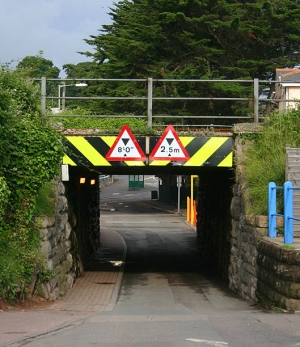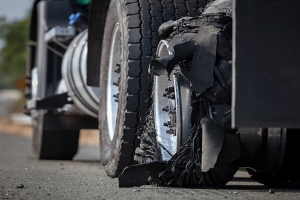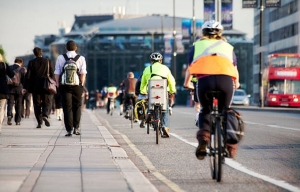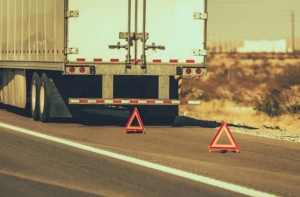Bridge Strikes
On average, large goods vehicles (LGVs) and buses hit five bridges across the UK every day. In 2019, Network Rail reported 1,787 bridge strikes, calling the situation unacceptable. The aftermath of these strikes is expensive, costing an average of £13,000 per incident, amounting to £23 million annually. The costliest single strike in 2019 led to £1.8 million in train delay costs. With Network Rail now able to claim these costs from hauliers, avoiding bridge strikes is crucial for both safety and financial reasons.
Common Causes of Bridge Strikes
- Drivers not knowing their vehicle height
- Poor route planning
- Using car sat navs that don't account for low bridges
- Misunderstanding or missing road signs
How to Avoid Bridge Strikes
Know Your Vehicle's Height
- If your vehicle's travelling height exceeds 3 metres, it’s legally required to display the correct height in the cab
- 43% of drivers admit they don’t measure their vehicle height before setting off
- HGV heights can change based on load, trailer adjustments, or coupler height. Always double-check and display the correct height after loading
Plan Your Route
- 52% of drivers don’t account for low bridges in their route planning
- Use vehicle-specific sat navs and refer to atlases or local authority resources that provide information on low bridge height limits
- If your vehicle exceeds 4.95 metres in height, consult local authorities to verify your route
- If diverted, drivers should stop and seek alternative routes to avoid low bridges
Pay Attention to Arched Bridges
- The height indicated on arched bridges only applies to the centre, marked by goalposts and white road lines
- If your load is 3 metres or more in width, the available height may be less than what’s signed
Understand the Signs
- Low bridges with heights under 4.95 metres are usually marked with advance warning signs
- Red circle signs prohibit access; red triangle signs warn of danger ahead
What to Do If You Hit a Bridge
- Don’t leave the scene – keep the vehicle where it is
- Report the strike immediately using the number displayed on the bridge's ID plate
- Call 999 and notify the police
- Keep the public at a safe distance
Consequences of a Bridge Strike
- Disruption to rail services and danger to passengers
- Delays and congestion on surrounding roads
- Prosecution of drivers, potentially leading to loss of licence or imprisonment
- Transport operators are liable for the cost of bridge repairs, recovery, and delayed rail services
Notable Example
One bridge on the A142 in Ely, Cambridgeshire, was hit 32 times in a single year.
By following these precautions, you can help prevent costly and dangerous bridge strikes. Stay aware, plan ahead, and always know your vehicle’s height.
Disclaimer
This information has been gathered from sources including GOV.UK and RoSPA. Although every effort has been made to ensure accuracy, Quicktemp and its affiliates accept no liability for any errors or omissions.
Breakdown Safety
Breaking down not only wastes time and money but also poses a significant risk, with 250 people killed or seriously injured on the hard shoulder every year. Knowing how to handle a breakdown is vital for your safety and that of other road users. Here’s how to avoid breakdowns and stay safe if one occurs.
How to Avoid a Breakdown
- Most breakdowns can be avoided with proper vehicle maintenance
- Ensure your vehicle is regularly serviced, including checks on wipers, tyres, and fluid levels
- Report any issues immediately
- Make sure you're familiar with the meaning of your vehicle's warning lights
Be Prepared
- Always have a charged mobile phone (switched off and stored safely while driving)
- Keep essentials like high-visibility clothing, a torch, water, and a reflective triangle
General Breakdown Procedures
- Avoid stopping in dangerous locations like roundabouts or bends. Never park on pavements
- Activate hazard lights immediately
- If possible, drive at a reduced speed to a safer spot off the road or onto a straight section
- Place the warning triangle at least 45 metres behind your vehicle (not on motorways)
- Call a breakdown service and wait for professional help
- Turn off the engine and wait in a safe location, away from traffic
Motorway Breakdown Procedures
- Exit at the next available opportunity or pull into a service area
- If you must stop, pull over to the hard shoulder, turn the wheels left, and park as close to the left as possible
- Switch on hazard lights and sidelights if visibility is poor
- Don’t use your warning triangle on the hard shoulder
- Wait for assistance and do not attempt repairs on the roadside
Tyre Blowout
- Tyre blowouts can make steering difficult, particularly with a front tyre failure
- Keep a firm grip on the steering wheel and slowly guide the vehicle to the left
- Reduce speed steadily and come to a stop on the hard shoulder or roadside
Calling for Help
- Use the nearest emergency phone on motorways, located via blue and white marker posts.
- If using a mobile, refer to the blue rectangular Driver Location Signs for the road number, travel direction, and location.
Waiting for Help
- Always leave the vehicle, ensuring everyone exits from the left-hand side.
- Walk off the road and, if possible, up an embankment or behind a crash barrier.
- Never attempt to cross lanes on a motorway.
By following these steps, you can stay safe and help ensure that your vehicle is recovered quickly in the event of a breakdown.
Disclaimer
This information has been gathered from sources including GOV.UK and RoSPA. Although every effort has been made to ensure accuracy, Quicktemp and its affiliates accept no liability for any errors or omissions.
Vulnerable Road Users
Certain groups on the road, such as motorcyclists, cyclists, horse riders, and pedestrians, are more vulnerable because they aren’t protected by a vehicle body and are harder for drivers to see. Awareness and extra caution can help prevent accidents.
Key Reminders
- Double-check for these road users before manoeuvring
- Stay aware of what’s happening around you
- Remember, many of these users don’t understand how commercial vehicles operate, so make allowances for them
Motorcyclists
- Although motorcyclists make up just 1% of UK road traffic, they account for 20% of all road fatalities
- Motorcyclists are 38 times more likely to be killed in accidents than car occupants per mile ridden
Tips
- Take longer to look for motorbikes, especially at junctions
- Check for motorcyclists before changing lanes or turning
- Don’t underestimate their speed when approaching a junction
- Maintain a safe distance; driving too close can intimidate less experienced riders
Cyclists
With the rise of cycling as a commuting option, the risks at junctions have increased. Cycle lanes allow cyclists to pass on the left of queuing traffic, which can lead to dangerous situations.
Key Facts
- Half of fatal collisions between trucks and bikes occur when trucks are turning left at junctions
Safety Tips
- Always double-check your blind spots before turning left
- Avoid overtaking cyclists and then turning across their path
- Give cyclists plenty of room when overtaking – at least 1 metre
- Be mindful of the turbulence your vehicle can create
Pedestrians
Pedestrians, especially children, the elderly, and disabled individuals, are among the most vulnerable on the road. Stay extra cautious in crowded areas and residential streets.
Did You Know?
- 60 child pedestrians are killed or seriously injured every week in the UK
- Nearly half of pedestrian fatalities are aged over 60
Tips
- Watch for distracted pedestrians, especially children who may dart into the road
- Be cautious when passing parked vehicles, especially near ice cream vans
- Allow extra time and space for older pedestrians or those with mobility challenges
Horse Riders
Accidents involving horses mostly occur on minor roads. Horses can be unpredictable and easily spooked.
Safety Tips
- Slow down and give horses plenty of room when passing
- Turn down your music and avoid revving your engine near horses
- Pay attention to signals from horse riders, as they may indicate they are turning
Overtaking and Mirrors
When overtaking or changing lanes on motorways, always check your wide-angle mirrors to ensure there’s no fast-approaching traffic. Most motorway accidents occur when vehicles shift lanes without checking properly.
Mirror Use
- Before setting off, ensure your mirrors give you a clear view down both sides of the trailer
- Stay aware of blind spots
- Use mirrors frequently to stay updated on your surroundings
- Always remember to mirror, signal, then manoeuvre – that final glance can prevent an accident
Being vigilant, particularly around vulnerable road users, can make a significant difference in keeping everyone safe. Stay alert, and always double-check your surroundings.
Disclaimer
This information has been gathered from sources including GOV.UK and RoSPA. Although every effort has been made to ensure accuracy, Quicktemp and its affiliates accept no liability for any errors or omissions.
Accidents and Emergencies
An accident is defined as any event where you have
- Damaged the road or highway
- Damaged third-party property
- Caused injury to someone other than yourself
- Damaged another vehicle or had your vehicle damaged by another party
No matter how minor the accident seems, follow this procedure
- Stop Immediately – Provide your name, address, vehicle registration, and owner details to anyone with a reasonable request
- Notify the Police – Report the accident to the police within 24 hours
- Inform Your Employer – Contact the team at Quicktemp and the client immediately
- Warn Other Traffic – Use hazard warning lights or a red warning triangle
- Never Admit Liability – Do not accept blame at the scene
- Stay Calm – Keep a level head and control your emotions
Gathering Information
While you’re only required to give your name and address, avoid admitting liability. If asked by the police, take a moment to gather your thoughts and provide a clear explanation of what happened.
Where possible, collect the following information from others involved
- Names and addresses of drivers/owners
- Registration numbers of other vehicles
- Names and addresses of witnesses
- Badge numbers of any police officers
- Insurance details of other drivers
Also, note
- The extent of damage
- Pre-existing damage/defects on vehicles
- Vehicle details (make, registration, tyre condition)
- Speeds, signals, and any horn use
- Positions of vehicles, road markings, traffic signs, etc.
Information to Record About Yourself
- Your name and date of birth
- Vehicle registration and any trailer numbers
- Details of damage to your vehicle
- Speed and whether you were signalling
- Date, time, and location of the accident
- Weather conditions and street lighting
- Witness information
- Sketch a map of the accident scene
Reporting the Accident
Report any accident that causes injury or damage to property, especially if it involves:
- Another person or animal not in your vehicle
- A vehicle other than yours
- Roadside property such as trees, lamp posts, or mailboxes
Accidents Involving Dangerous Substances
If an accident involves hazardous materials, the ADR-certified driver is the most qualified to handle the situation until emergency services arrive. The main risks include fire and the release of dangerous substances.
Fire
Fire requires three elements: oxygen, fuel, and ignition (from sources like sparks, cigarettes, or faulty wiring). Fires are extinguished by removing one of these elements.
All ADR vehicles must carry fire extinguishers
- One 2kg dry powder extinguisher for cab fires
- One 6kg dry powder extinguisher for load fires
When tackling a fire
- Prioritise your own safety
- React calmly and assess the situation
- Only tackle the fire if it is safe
- Move people away from the fire area
- Never fight fires involving pressurised containers (e.g. aerosols)
Preventing Fire
- Regularly check and maintain your vehicle
- Keep the cab free of rubbish and potential ignition sources
- Avoid loading flammable materials with oxidizers
Release of Dangerous Substances
- Provide details of your load and location
- Assist injured individuals if safe
- Secure the Scene
- Move the vehicle to a safer location if possible.
- Stop the engine.
- Provide emergency services with load details.
- Use protective gear and isolate the battery if necessary.
- Keep people and ignition sources away.
- Use warning triangles and contain the spillage if safe.
Never
- Put yourself in danger
- Fight large fires with a cab extinguisher
- Enter confined spaces where gas build-up is possible
When Emergency Services Arrive
- Provide them with all relevant load details
- Inform them of any actions you’ve taken
- Notify the client and the team at Quicktemp as soon as possible
Breakdown Procedure
- Move to a Safe Location – Avoid obstructing traffic or causing an accident.
- Inform the Client – Providing:
- Your name and contact details
- Vehicle location and status (loaded or not)
- Remaining delivery points
- Vehicle make, model, and registration
- Specific details about any faults (e.g., tyre size, tail-lift model, or windscreen damage)
For breakdowns on motorways, ensure the police are informed and updated as your situation progresses.
Disclaimer
This information has been gathered from sources including GOV.UK and RoSPA. Although every effort has been made to ensure accuracy, Quicktemp and its affiliates accept no liability for any errors or omissions.
UK Invests £10.5m to Streamline New EU Border Check Process
The UK government has announced £10.5 million in funding to help ports prepare for the new EU border checks that are set to be introduced this autumn. This financial support will assist the Port of Dover, Eurotunnel at Folkestone, and Eurostar at St Pancras in implementing the EU's new Entry/Exit System (EES).
The EES will require travellers from the UK and other non-EU countries to undergo digital border checks, including the capture of biometric data such as fingerprints and photographs. This system is intended to replace traditional passport stamping, with registration valid for three years after the initial entry. The government’s funding is aimed at equipping these ports with the necessary technology to ensure smooth processing and reduce queue times for travellers.
Initially scheduled to begin in 2022, the EES has faced several delays and is now expected to launch in November 2024. The funds will be used by the Port of Dover to expand its processing facilities, while Eurostar and Eurotunnel will focus on upgrading technology and training staff to meet the new requirements. Transport Minister Lilian Greenwood highlighted the importance of minimizing queue times at the ports, despite the EES being an EU-led initiative. Officials from Eurostar and Getlink, which manages Eurotunnel, have also emphasised their commitment to a smooth transition, having already invested significant resources in preparation for the system's rollout.
Each port is set to receive £3.5 million from the government to support these preparations, marking the first allocation of funds specifically aimed at preventing delays related to the EES. This investment is expected to play a crucial role in ensuring that the new border checks do not cause significant disruptions for travellers.










